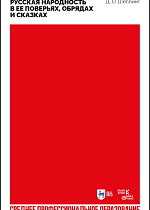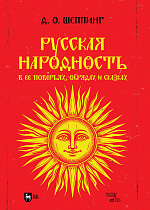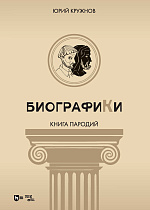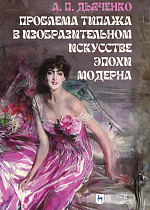История культуры - все книги по дисциплине. Издательство Лань
Сохранить список:
Excel
Excel
Закрыть
Выгрузка списка книг доступна только авторизованным пользователям. Авторизоваться
Вниманию читателя представлена широко известная, капитальная работа русского историка, археолога и этнографа Дмитрия Оттовича Шеппинга (1823–1895), посвящённая истории русского фольклора. Основной целью книги является осмысление вопросов, связанных с духовным миросозерцанием русского народа. Автор дает краткий очерк русской мифологии, исследует русские сказки и былины, раскрывает особое значение таких фигур, как Купало и Коляда, Род и Рожаница, Перун, Волос и Иван-царевич в истории русского народа.
Соответствует современным требованиям Федерального государственного образовательного стандарта среднего профессионального образования и профессиональным квалификационным требованиям. Настоящее издание предназначено для студентов и преподавателей средних специальных учебных заведений, специалистов и широкого круга читателей, интересующихся вопросами славянских древностей.
Here’s to your attention the well known, fundamental work by Dmitry Ottovich Shepping (1823–1895), the Russian historian, archaeologist and ethnographer. The book is dedicated to the history of Russian folklore. It is aimed chiefly to understand the issues related to the spiritual worldview of the Russian people. The author gives a brief outline of Russian mythology, examines Russian fairy tales and epics, reveals the special significance of such figures as Kupalo and Koliada, Rod and Rozhanitsa, Perun, Veles and Ivan Tsarevich in the history of the Russian people.
Сorresponds to the modern requirements of the Federal State Educational Standard of Secondary Vocational Education and professional qualification requirements. The current edition is intended for students and teachers of colleges, experts and a wide range of readers interested in issues of Slavic antiquities.
Соответствует современным требованиям Федерального государственного образовательного стандарта среднего профессионального образования и профессиональным квалификационным требованиям. Настоящее издание предназначено для студентов и преподавателей средних специальных учебных заведений, специалистов и широкого круга читателей, интересующихся вопросами славянских древностей.
Here’s to your attention the well known, fundamental work by Dmitry Ottovich Shepping (1823–1895), the Russian historian, archaeologist and ethnographer. The book is dedicated to the history of Russian folklore. It is aimed chiefly to understand the issues related to the spiritual worldview of the Russian people. The author gives a brief outline of Russian mythology, examines Russian fairy tales and epics, reveals the special significance of such figures as Kupalo and Koliada, Rod and Rozhanitsa, Perun, Veles and Ivan Tsarevich in the history of the Russian people.
Сorresponds to the modern requirements of the Federal State Educational Standard of Secondary Vocational Education and professional qualification requirements. The current edition is intended for students and teachers of colleges, experts and a wide range of readers interested in issues of Slavic antiquities.
Вниманию читателя представлена широко известная, капитальная работа русского историка, археолога и этнографа Дмитрия Оттовича Шеппинга (1823–1895), посвящённая истории русского фольклора. Основной целью книги является осмысление вопросов, связанных с духовным миросозерцанием русского народа. Автор дает краткий очерк русской мифологии, исследует русские сказки и былины, раскрывает особое значение таких фигур, как Купало и Коляда, Род и Рожаница, Перун, Волос и Иван-царевич в истории русского народа.
Настоящее издание предназначено для специалистов и широкого круга читателей, интересующихся вопросами славянских древностей.
Here’s to your attention the well known, fundamental work by Dmitry Ottovich Shepping (1823–1895), the Russian historian, archaeologist and ethnographer. The book is dedicated to the history of Russian folklore. It is aimed chiefly to understand the issues related to the spiritual worldview of the Russian people. The author gives a brief outline of Russian mythology, examines Russian fairy tales and epics, reveals the special significance of such figures as Kupalo and Koliada, Rod and Rozhanitsa, Perun, Veles and Ivan Tsarevich in the history of the Russian people.
The current edition is intended for experts and a wide range of readers interested in issues of Slavic antiquities.
Настоящее издание предназначено для специалистов и широкого круга читателей, интересующихся вопросами славянских древностей.
Here’s to your attention the well known, fundamental work by Dmitry Ottovich Shepping (1823–1895), the Russian historian, archaeologist and ethnographer. The book is dedicated to the history of Russian folklore. It is aimed chiefly to understand the issues related to the spiritual worldview of the Russian people. The author gives a brief outline of Russian mythology, examines Russian fairy tales and epics, reveals the special significance of such figures as Kupalo and Koliada, Rod and Rozhanitsa, Perun, Veles and Ivan Tsarevich in the history of the Russian people.
The current edition is intended for experts and a wide range of readers interested in issues of Slavic antiquities.
Что такое «Биографики»? – спросите вы. Наверное, надо начать с эпохи императора Веспасиана. Во II в. до н. э. этот римский император помог получить римское гражданство греческому гражданину по имени Плутарх. Замечательный грек собрал за свои 70 прожитых лет более 200 биографий, порой написанных, правда, не им, и (что характерно), почти 50 из них сохранились до наших дней. Они собраны в книгу «Сравнительные жизнеописания» в двух томах. Этим трудом Плутарх положил начало жанру художественной биографии. Жанр просуществовал не одно тысячелетие и существует благополучно до сих пор. Замечательней всех оказались биографы советской поры. Ими написаны тысячи и тысячи биографий, похожих одна на другую как две капли воды.
Здесь автор постарался «сжать» в руке написанные в советское время биографии известных людей. Таким вот образом биографии превратились в биографиКи. Вода из них, действительно, вытекла, но что осталось – то осталось.
What are “Biographics”, you may ask. Perhaps we should go back to the Emperor Vespasian era. In the 2nd century BC, this Roman emperor helped a Greek citizen named Plutarch get a Roman citizenship. During his 70 years of life, this remarkable Greek collected more than 200 biographies, sometimes written, however, not by him, and (what is characteristic) almost 50 of them have survived to this day. They are included in the book “Parallel Lives” in two volumes. With this work, Plutarch laid the foundation for the genre of fictional biography. The genre has existed for more than one millennium and exists successfully to this day. The most remarkable of all were the biographers of the Soviet era. They wrote thousands and thousands of biographies, similar to each other like two peas in a pod.
The author of this book tried to “compress” the biographies of famous people written in Soviet times. In this way the biographies turned into biographics. The water really did flow out of them, but what has left, has left.
Здесь автор постарался «сжать» в руке написанные в советское время биографии известных людей. Таким вот образом биографии превратились в биографиКи. Вода из них, действительно, вытекла, но что осталось – то осталось.
What are “Biographics”, you may ask. Perhaps we should go back to the Emperor Vespasian era. In the 2nd century BC, this Roman emperor helped a Greek citizen named Plutarch get a Roman citizenship. During his 70 years of life, this remarkable Greek collected more than 200 biographies, sometimes written, however, not by him, and (what is characteristic) almost 50 of them have survived to this day. They are included in the book “Parallel Lives” in two volumes. With this work, Plutarch laid the foundation for the genre of fictional biography. The genre has existed for more than one millennium and exists successfully to this day. The most remarkable of all were the biographers of the Soviet era. They wrote thousands and thousands of biographies, similar to each other like two peas in a pod.
The author of this book tried to “compress” the biographies of famous people written in Soviet times. In this way the biographies turned into biographics. The water really did flow out of them, but what has left, has left.
Учебное пособие по специальности “История мирового искусства” посвящено проблеме типажа в мировом изобразительном искусстве конца XIX – начала XX века. Рассмотрены характерные черты типологических образов, свойственных эпохе модерна. Типажи описаны в контексте исторического времени и в тесной связи с деятельностью живописцев и графиков, воплотивших описываемые образы в своем творчестве. Книга призвана расширить представления читателей о художественной культуре эпохи рубежа веков.
Пособие предназначено для студентов высших учебных заведений, обучающихся по специальностям «изобразительное искусство» и «искусствоведение», а также для широкого круга читателей, интересующихся художественной культурой.
A textbook intended for the «History of World Art» specialty is devoted to the problem of a typical model in the world fine arts of the late 19th — early 20th centuries. The author studies the characteristic features of typological images characteristic of the modern era. The typical models are described in the context of historical epoch and in close connection with the work of painters and graphic artists who embodied the described images in their art. The book has to expand the readers' understanding of the artistic culture of the turn of the century.
The textbook intended for students of higher schools studying the fine arts and art history, as well as for a wide range of readers interested in artistic culture.
Пособие предназначено для студентов высших учебных заведений, обучающихся по специальностям «изобразительное искусство» и «искусствоведение», а также для широкого круга читателей, интересующихся художественной культурой.
A textbook intended for the «History of World Art» specialty is devoted to the problem of a typical model in the world fine arts of the late 19th — early 20th centuries. The author studies the characteristic features of typological images characteristic of the modern era. The typical models are described in the context of historical epoch and in close connection with the work of painters and graphic artists who embodied the described images in their art. The book has to expand the readers' understanding of the artistic culture of the turn of the century.
The textbook intended for students of higher schools studying the fine arts and art history, as well as for a wide range of readers interested in artistic culture.
В книге высказывается гипотеза о происхождении невербальной коммуникации, использующей знаковые символы. Автор излагает материал на примере ткацких артефактов, которые используются в качестве символических знаков. В результате анализа обширного этнографического материала, связанного с ткачеством, были выделены и классифицированы символические значения веревки и нити, которые совпали по своему значению с функциями, выполняемыми ими в обыденной жизни и трудовых технологиях. Понимание тайны происхождения невербальных знаков и их символики возможно в кросс-культурных исследованиях. Книга рассчитана на читателей, интересующихся историей и философией культуры.
The book contains a hypothesis about the origins of non-verbal communication using the sign symbols. The author presents the material with the example of weaving artifacts, which are used as symbolic signs. As a result of the analysis of extensive ethnographic material related to weaving, the symbolic meanings of rope and thread were identified and classified, which coincided by their meaining with their functions in everyday life and labor technologies. Understanding the mystery of the origin of non-verbal signs and their symbolism is possible in cross-cultural studies. The book is intended for readers interested in history and philosophy of culture.
The book contains a hypothesis about the origins of non-verbal communication using the sign symbols. The author presents the material with the example of weaving artifacts, which are used as symbolic signs. As a result of the analysis of extensive ethnographic material related to weaving, the symbolic meanings of rope and thread were identified and classified, which coincided by their meaining with their functions in everyday life and labor technologies. Understanding the mystery of the origin of non-verbal signs and their symbolism is possible in cross-cultural studies. The book is intended for readers interested in history and philosophy of culture.






